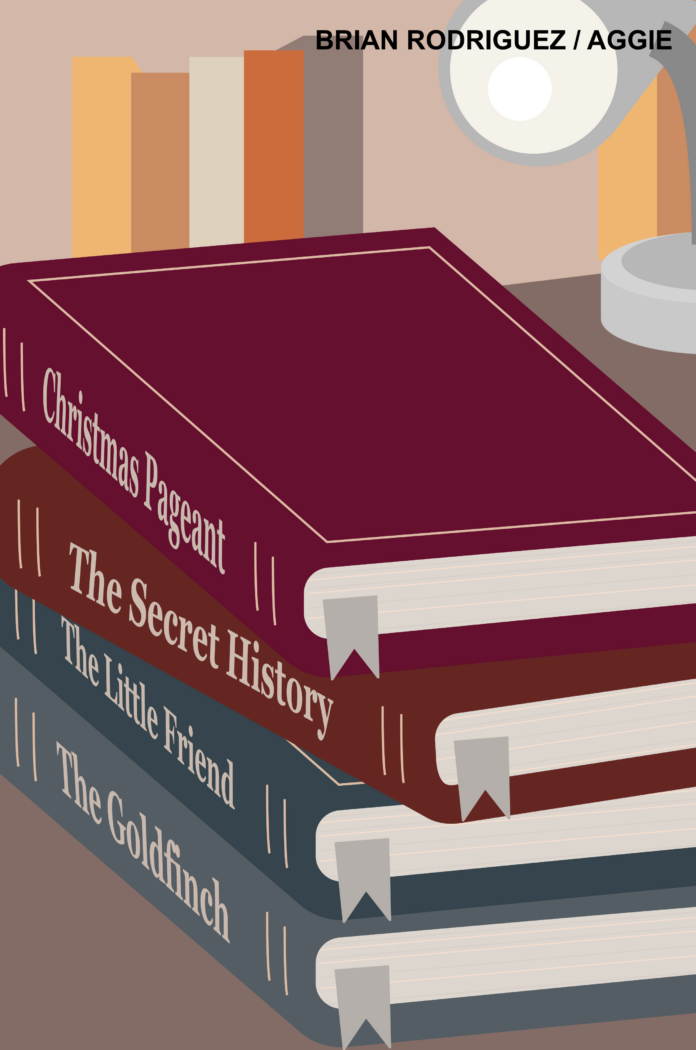Examining the author’s body of work and the diversity it contains
By JULIE HUANG — arts@theaggie.org
Donna Tartt’s body of work remains enigmatic no matter how many times one goes back to revisit it. Having penned three novels across three decades, Tartt’s characters are often the highlight of her books, jumping off the page with every detail that she adds and forming vivid portraits that color the impressions readers are left with. Yet every portrait is clearly distinct, as none of her three novels overlap much in setting and circumstances. From rich college kids engaging in questionable acts, a lonely twelve-year-old girl in Mississippi and a boy in New York City whose life is uprooted following a catastrophic accident, Tartt’s protagonists seem to occupy different spaces within her body of work.
“The Secret History” (1992)
“The Secret History” is known among online circles, especially some parts of TikTok, for being a “dark academia” thriller that doubles as a complex character study of arrogant college students. In essence, the protagonist Richard Papen falls in with a group of beautiful, wealthy and enviable classics majors who have a lot of free time and not as many morals. Richard, as an outsider brought into that inner circle, is able to give a unique account of their strange doings with a perspective that no one else can hold, and Tartt masterfully explores his reverent but uneasy attitude toward his elevated peers. Although the novel is now decades old, “The Secret History” has become and remains for many the novel that they envision when they think of the scandal, intrigue and moral deterioration associated with dark academia and its related aesthetics. Although placing such a simple label on the novel may distill some of its nuance, it also makes the book palatable to a wider audience, a strength that helps it outshine Tartt’s next work in the public eye.
“The Little Friend” (2002)
Perhaps Tartt’s most intimate work, “The Little Friend” is her least known and least acclaimed novel. It follows twelve-year-old Harriet Dufresnes in 1970s Mississippi as she imagines herself a worthy detective on the hunt for her older brother’s very real murderer. The murder, having happened years before, haunts the narrative and looms like a shadow over Harriet’s upbringing and growth from child to adolescent. Far from the thrill that “The Secret History” does so well, “The Little Friend” is slow and unsettling, revealing itself not as a plot-driven tale of suspense, but rather a nuanced study of the human mind. With such an all-encompassing subject as its centerpiece, it is no wonder that “The Little Friend” ends up being too lengthy and verbose for many readers. Still, despite being less positively received than her other works, one can tell that Mississippi native Tartt takes painstaking care to stay true to the details of her birthplace in her writing, granting a clear sense of authorial affection to her sophomore work.
“The Goldfinch” (2013)
As a Pulitzer Prize winner, “The Goldfinch” is perhaps Tartt’s most well-known and critically acclaimed novel, even having been adapted into a film of the same name. Its protagonist, Theo Decker, has been called Dickensian due to both his parental status and the desperate, strange life that he leads, 14 years of which are followed throughout nearly 800 pages. Although longer than “The Little Friend” by a significant amount, “The Goldfinch” also differs in that it changes settings and scenes quite frequently. Characters within the narrative come and go, and these changes feel reminiscent of real life, breathing fresh air into pages that might otherwise feel too heavy to bear. The novel has been lauded as a feat of storytelling, and yet it remains difficult to summarize the immense range of the places and people that it features.
Ultimately, choosing the best novel from among these three may be a pointless endeavor. It is difficult to point to any one of them and accurately claim that it sums up the entirety of Tartt’s career, as they all cover very different ground in terms of character arcs, setting and plot. The most significant common thread that can be traced among these distinct novels is the attention to detail and devotion to vivid, humanistic storytelling that Tartt embodies.
Written by: Julie Huang — arts@theaggie.org





